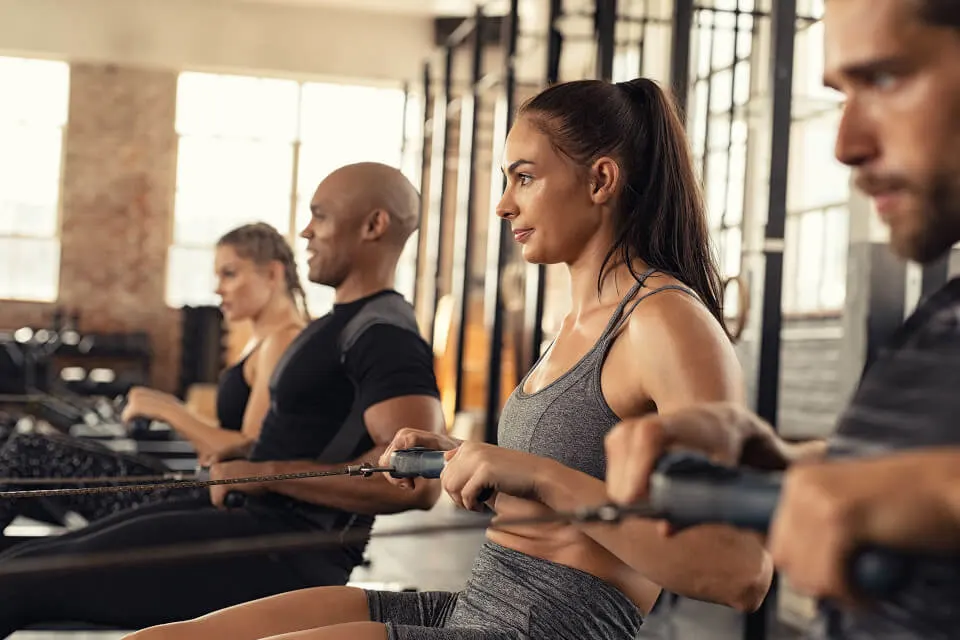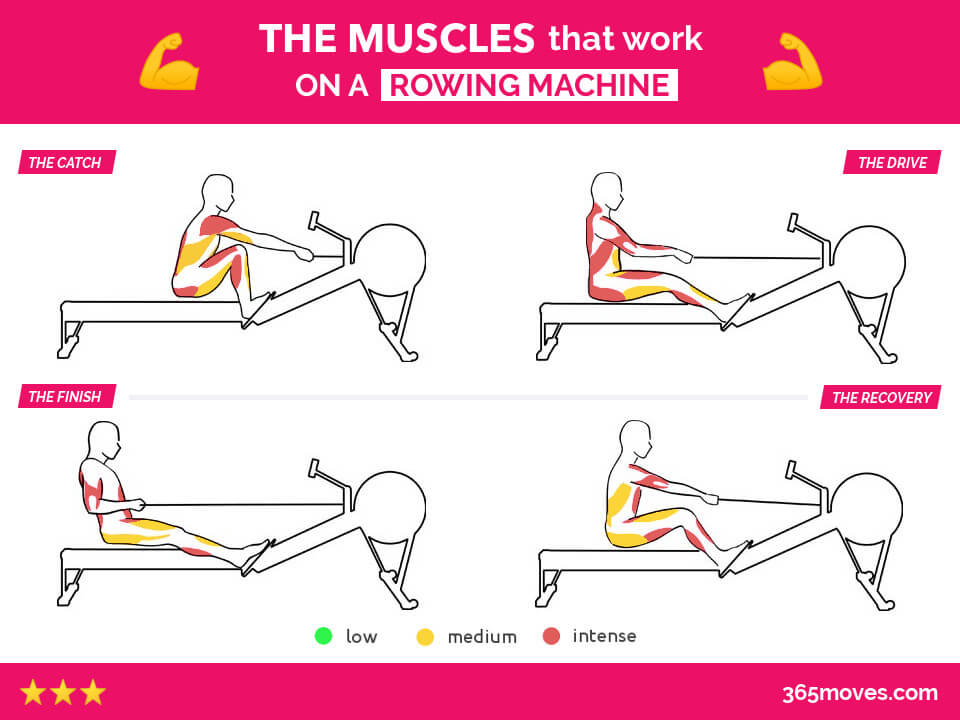10 Amazing Health Benefits of Rowing Machine

The rowing machine is a great way to gain muscle and strengthen your arms, legs, thighs and abs while losing weight. But did you know that working out on a rowing machine also has many benefits for your body and your health? Not only does it give you a sense of well-being and happiness through the secretion of specific hormones, reduces stress and anxiety, helps you feel more confident, but it is also extremely effective against bad cholesterol and reduces the risk of various diseases. Although little known, these positive effects of exercise are very powerful!
Here are the top 10 health benefits of exercising on a rowing machine.
1. Rowing has great benefits for your heart health
Rowing, whether indoors or outdoors, works the most important muscle of all: the heart! And like all muscles, it must be trained regularly to become stronger.
A well-trained heart induces a lower heart rate, both at rest and during exercise. It therefore beats less often and is less stressed. Blood pressure, which ensures the circulation of blood in our arteries, is also lower when the heart is more muscular because it ejects a greater volume of blood with each contraction.
If you exercise regularly on your rowing machine, you will improve your cardio-respiratory capacity. In particular, you will be able to exert yourself without getting out of breath too quickly.
These beneficial effects of sport and exercise on the heart reduce the risk of cardiovascular disease. People who practice regular physical activity have a lower risk of suffering a stroke (cardiovascular accident).
These health benefits appear after a few weeks if you exercise at least 2 to 3 times a week for 30 to 45 minutes per session. To see for yourself, measure your pulse rate at rest and observe the improvement after 3 to 4 weeks.
The rowing machine, as an endurance exercise, is ideal for training your heart!
2. Is the rowing machine good for lungs and breathing capacity?
In fact, regular rowing does not increase lung capacity, which corresponds to the volume of air that can be inspired. On the contrary, activities such as swimming or snorkeling do have a real impact on lung capacity. On the other hand, sports and physical activity increase muscle performance, so that the muscles need less oxygen during exercise and produce less carbon dioxide. This means you won't get out of breath as quickly during exercise as you would if you weren't used to exercising. In addition, exercising regularly can help you improve your breathing capacity as you learn to better manage the rate and intensity of your breathing during exercise.
People with chronic lung disease, such as asthma or COPD, can improve their symptoms by exercising. If you have this condition, you should always ask your doctor's advice before engaging in physical activity.
WHAT YOU SHOULD KNOW:
Lung capacity is not related to physical performance. Scientific studies have shown that professional athletes do not have greater lung capacity than non-athletes, including marathon runners.
3. The rowing machine to gain muscle and strengthen arms, legs, thighs and abs
Exercising on a rowing machine is great for toning your legs, thighs and buttocks, but also your arms, abs and back muscles. Your muscles work especially hard when you increase the resistance on your rowing machine. A low resistance level is good for warming up and improving endurance, but not for gaining muscle. No pain, no gain ;)
The advantage of the indoor rowing machine over the outdoor rower is that you can choose the intensity with which you want to work your muscles. The more you increase the resistance of your machine, the more you work your muscles and build muscle mass.

The muscles that work on a rowing machine for each position
Rowing is a coordinated action that involves a very large number of muscles, both in the lower and upper body:
- The biceps and triceps, muscles of the front and back of the arms. At the drive and at the finish, the biceps work to pull the handle, while the triceps work at the catch to extend the arms and at the recovery to push the arms forward.
- The abdominal muscles or abs stabilize the body at the finish and flex the torso forward at the recovery.
- The back muscles work harder at the drive and the finish.
- The shoulder muscles contract during the drive.
- The quadriceps or quads and the hamstrings, muscles of the front and back of the thigh, work alternately as you row, especially during catch and drive for the quads and during recovery for the hamstrings.
- The gluteal muscles or glutes (large, medium and small buttocks) also work during exercise, more so during the catch and the drive.
- The calf muscles, called triceps sural, located at the back of the leg, work almost constantly.
WHAT YOU SHOULD KNOW:
Results don't happen overnight, unfortunately... and your arms or legs won't double in size! In fact, you have to train regularly and persevere to see results ;).
4. The benefits of the rowing machine for losing weight
Using a rowing machine can help you burn a lot of calories and is very effective for weight loss. What you need to know is that the higher the intensity of your exercise, the more calories you will burn. However, the higher the intensity of your workout, the harder it is to keep rowing for a long time... It's up to you to find the right balance.
A good training plan is to alternate between a long, low or medium intensity cardio workout 1-2 times a week and a high intensity (HIIT) workout once a week. Do one or two rowing workouts per week and one or two sessions of cycling on your stationary bike or cross trainer for example. Rowing is very demanding and if you want to do a long, low-intensity cardio workout, you should rather opt for an exercise bike.
How many calories does 30 minutes of rowing burn? and 1 hour?
On average, rowing will burn the following calories:
- Rowing moderately hard will burn 295 kcal in half an hour (590 in 1h)
- Rowing vigorously will burn 359 kcal in half an hour (718 in 1h)
In comparison, walking for 30 minutes will burn 105 Calories (kcal) and 210 in an hour.
To lose 1 kg, you should exercise 30 minutes on your rowing machine 3 times a week for one month and a half. For more information, read our article on how to lose weight on your stationary bike.
Is rowing a good exercise to lose weight?
The rowing machine not only helps you burn calories and fat, but also strengthens and tones your legs, thighs, arms and buttocks. However, it is essential to combine a healthy, balanced diet with regular training if your goal is to lose weight and get an athletic figure!
5. Rowing reduces the risk of type 2 diabetes
Endurance sports such as rowing, running or cycling on an exercise bike have many benefits for people with diabetes. When we exercise or play sports, our muscles use glucose and, as a result, blood sugar levels are lowered. Diabetes is characterized by an excess of sugar in the blood. Many scientific studies have shown that sport and physical activity lower blood sugar levels in diabetics.
Physical activity also has a beneficial effect on insulin. Insulin is a hormone produced by the body that regulates blood sugar levels, particularly by lowering blood sugar levels after meals. In diabetics, insulin no longer plays its role properly, which leads to an increase in blood sugar levels. Sport and regular physical activity make the body more sensitive to insulin. This means that the amount of insulin needed to lower the blood sugar level is reduced. Sport therefore promotes better natural regulation of blood sugar levels.
6. Exercising on your rowing machine can lower your cholesterol
Cholesterol is not bad in itself, it is just excess cholesterol that increases the risk of cardiovascular disease. However, it is important to differentiate between "good" and "bad" cholesterol.
What you need to know is that sport promotes good cholesterol and reduces bad cholesterol. These benefits and positive effects of sport on cholesterol have been analyzed in numerous scientific studies and it is recommended that people with cholesterol problems do sport and practice physical activity regularly!
7. Rowing can make you feel good by releasing endorphins!
When you exercise on an indoor rowing machine, your body secretes hormones, including endorphins and serotonin, that make you feel good. These hormones, known as happy hormones, regulate mood, stress and anxiety. They explain the feeling of happiness that exercise induces as well as the anti-stress and anti-depressant effect of sport.
If you want to get your dose of endorphins and experience the euphoric feeling commonly described as the "runner's high", you should exercise on your rowing machine for at least 45 minutes to 1 hour, if not more!
Learn more about the effects of exercise on the brain.
WHAT YOU SHOULD KNOW: Rowing can also help you quit smoking! Indeed, the production of endorphins stimulated by the practice of an endurance sport attenuates the symptoms of dependence and can thus help smokers to stop smoking.
8. The rowing machine: a gentle sport for your joints
The rowing machine is a low-impact sport that works the joints in a gentle. It is a no-impact exercise.
The rowing machine is good for strengthening back muscles but if you already have back problems, you should be careful, as the movement of your arms and shoulders may be contraindicated. Speak with your doctor beforehand if you want to use a rowing machine against your back problems or for rehabilitation.
However, for rehabilitation after a knee or ankle sprain, the stationary bike is generally more recommended than the rowing machine because it involves a slower and gentler movement.
9. The benefits of the exercise rowing machine against degenerative diseases such as Alzheimer's and Parkinson's
Rowing is a gentle sport that can be done at home throughout your life, even at an advanced age. It is very important, especially after the age of 60, to stay active and continue to exercise and play sports regularly!
Indeed, many scientific studies have shown that physical activity, if practiced regularly, could reduce the risks and delay the symptoms of degenerative diseases such as Alzheimer's or Parkinson's. This is because exercise stimulates certain areas of the brain. Recent studies also point out that it is never too late to start, as sport can already be beneficial after a few weeks.
As more and more doctors are saying, sport is the best prevention against age-related diseases!
10. Rowing is good for your health and for living longer!
Regular exercise can also increase your life expectancy! Many scientific studies have shown that regular exercise can not only reduce the risk of many diseases, delay their onset and alleviate some symptoms, but also preserve the effectiveness of the immune system of older people for longer, thus increasing their life expectancy.
According to Dr. Chi Pang Wen's study, which involved more than 400,000 people over 12 years, an average of 15 minutes of physical activity per day could increase life expectancy by 3 years!
The rowing machine health benefits are truly impressive!
Regular training on your rowing machine or your rower has great benefits for your body, your health and your mood! Exercise and sport help us to feel good and this positive effect is not only psychological: our body really needs it. You could almost say that our body thanks us every time we exercise by releasing a dose of happy hormones!
Now you know all about the extraordinary health benefits of rowing! Share this article and spread the word: many people still don't do any physical activity. The first step to any change is awareness!

Clara Miller
Fitness Writer
Clara Miller has a Master's degree in Sports Science and has worked for famous sports and fitness brands. She is passionate about sports and regularly writes about fitness, weight loss and motivation for various blogs and magazines.
